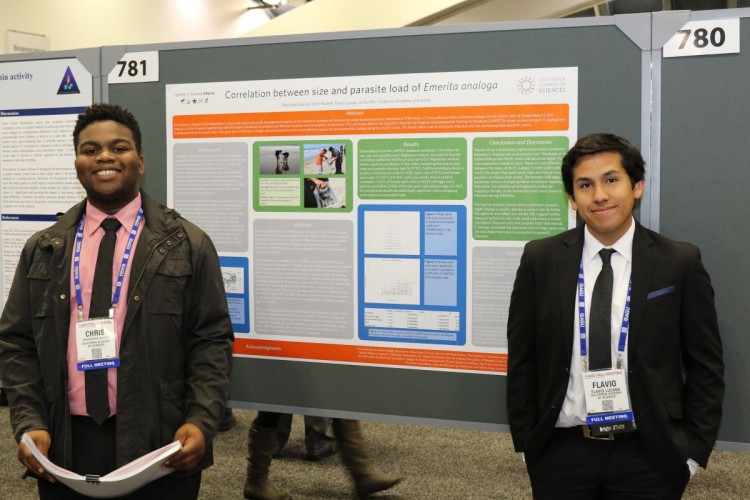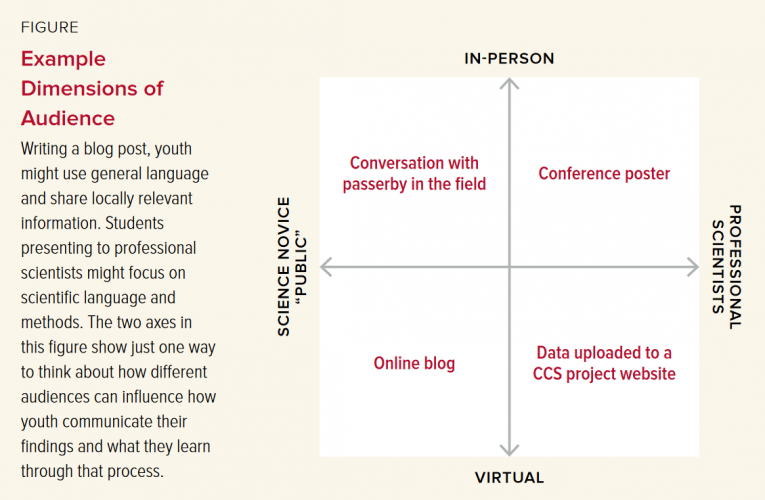Brief: Youth Share Findings with Outside Audiences
Download a pdf version of this Research Brief
When youth share their science findings, we found that they become motivated and take ownership of their findings. This key practice* requires creating opportunities for youth to share the results of their scientific work with audiences beyond their classroom, out-of-school program, or family unit. Community and Citizen Science (CCS) can expand the typical audiences to include scientists, policy-makers, community stakeholders and leaders, other CCS participants, and the general public. Audiences may be in-person or online. They may be anticipated by educators, such as a presentation at a scientific conference, or unanticipated, such as neighbors passing by during data collection. Audiences can play multiple roles; they can simply listen to young people, use the data or findings, provide feedback, or make decisions based on what they’ve learned.
Case 1: Presenting at a Scientific Conference
 Every Thursday after school, from
September through November, a group of three high school students
worked together, preparing a research poster for a large
international scientific conference, which is attended by
thousands of professional scientists. As part of a summer
internship at a local science museum, these young people had
collected and submitted data about Pacific mole crab (Emerita
analoga) to the Long-Term Monitoring Program and Experiential
Training Program for Students (LiMPETS), a regional citizen
science project that monitors the abundance and distribution
Every Thursday after school, from
September through November, a group of three high school students
worked together, preparing a research poster for a large
international scientific conference, which is attended by
thousands of professional scientists. As part of a summer
internship at a local science museum, these young people had
collected and submitted data about Pacific mole crab (Emerita
analoga) to the Long-Term Monitoring Program and Experiential
Training Program for Students (LiMPETS), a regional citizen
science project that monitors the abundance and distribution
of the Pacific mole crab along the coast of California. They were
nervous and excited as they prepared to present their research
about the prevalence of a parasite (Profilicollis altmani) in the
Pacific mole crab.
Afterwards, one girl, Evan, expressed her excitement about being
seen and respected by professional scientists, explaining, “I
never would have imagined that such a young generation could
communicate with, like, the older generation who have
accomplished so much, and just kind of be on a somewhat level
playing field… they’ll respect us despite being kids.” At the
conference,
they gave their presentation to over twenty different scientists
and youth participants, and left feeling proud of themselves and
their contribution to science.
Case 2: Blogging about Science
Across town, another group of students were working with the same
LiMPETS data but publishing their results in a class blog. The
blog, written for members of the public, made school feel more
relevant for some students, including Sydney, who reflected on
how “[the blog] is much more to me personally than an assignment.
It’s kind of like something that I can share with people, and
that
other people can see, and I think that’s really, really cool for
me.” It was important to Sydney that what the group was learning
about the Pacific mole crab would be shared with members of the
public, and her family and friends.
Why It’s Good for Learning
 Sharing findings with an authentic
audience can positively influence young learners’ engagement in
scientific practice, motivation, and position within scientific
communities. Accountability to an outside audience has been found
to increase young people’s use of scientific language and norms.
[1] It can also break down the isolation of the classroom [2] and
can encourage extra revision and organization of understanding
[3]. Presenting to an outside audience helps to position
youth as community science experts [4] making a visible and
valued contribution to their communities.
Sharing findings with an authentic
audience can positively influence young learners’ engagement in
scientific practice, motivation, and position within scientific
communities. Accountability to an outside audience has been found
to increase young people’s use of scientific language and norms.
[1] It can also break down the isolation of the classroom [2] and
can encourage extra revision and organization of understanding
[3]. Presenting to an outside audience helps to position
youth as community science experts [4] making a visible and
valued contribution to their communities.
Our research builds on this work, showing that sharing findings with outside audiences can help young people develop environmental science agency. [5] As illustrated by the stories above, we found that sharing their findings helped young people see themselves as experts because they were recognized by scientific communities, local community governments, and members of the public. In addition, we found that working with outside audiences helped expand young people’s ideas about possible future career paths, providing an important foundation for future individual and community change.
Tips for Implementing
- Determine the appropriate audience based on your goals. The quadrants in the figure above provide one example of how to think about different audiences. Not all require extensive work on the part of educators. Short conversations with people passing by a research site or posting work online can position students as experts. In addition, scientists and members of the public have different norms for verbal and written communication. The kind of audience you choose has implications for the kind of language and norms young people learn about.
- Emphasize audience so that it builds buy-in but doesn’t overwhelm the project focus. A real audience can be rewarding but also cause anxiety. Make sure to support young people so they feel pride in their accomplishments without unnecessary stress.
- Prepare youth with audience-appropriate scaffolds. It is important to provide scaffolding throughout a project so young people are ready to present their findings. Example scaffolds include: practicing public speaking through “lightning talks” or writing practice blogs in the appropriate genre.
- Plan for collaboration between educators and community members. Try to collaborate with CCS project staff, other scientists, community members or local city government if those are appropriate audiences. Collaboration takes time so start conversations early.
References
[1] Heath, S. B. (2000). Making learning work. After School Matters, 1(1), 33-45.
Heath, S. B. (2004). Risks, rules, and roles: Youth perspectives on the work of learning for community development. In A. N. Perret-Clermont, C. Pontecorvo, L. B. Resnick, T. Zittoun & B. Burge (Eds.), Joining Society: Social interaction and learning in adolescence and youth. (pp. 41-70). New York: Cambridge University Press.
O’Neill, D. K. (2001). Knowing when you’ve brought them in: Scientific genre knowledge and communities of practice. The Journal of the Learning Sciences, 10 (3), 223-264.
[2] Barron et al. (1998): Doing With Understanding: Lessons From Research on Problem- and Project-Based Learning, Journal of the Learning Sciences, 7 (3-4), 271-311.
[3] Okita, S. Y., & Schwartz, D. L. (2013). Learning by teaching human pupils and teachable agents: The importance of recursive feedback. Journal of the Learning Sciences, 22 (3), 375-412.
[4] Calabrese-Barton, A. C., & Tan, E. (2010). We be burnin’!: Agency, identity and science learning. Journal of the Learning Sciences, 19 (2), 187-229.
[5] Ballard, H. L. et al. (2016). Youth-focused citizen science: Examining the role of environmental science learning and agency for conservation. Biological Conservation. Online corrected proof. https://doi.org/10.10
* Key practices for youth in youth-focused community and citizen science (YCCS) can lead young people to be more motivated and engaged in scientific practice, see themselves as part of scientific and local communities, broaden possible career paths, and foster youth agency with environmental science
Attachment








